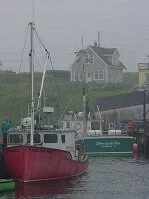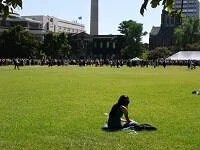
Fishing Village
For most working urban dwellers life has a fairly regular routine with most jobs starting at about 9:00 am and ending at about 5:00 pm. During these times prior to and after work the roads tend to fill with traffic and public transportation options are filled. However, beyond this working schedule the way of life is quite drastically different from person to person. The English-speaking population tends to eat dinner earlier than the French who often eat as late as 9:00 pm. For families with children after-school activities take up much time, while for others evenings may be filled with socializing, watching TV, or any other number of things.
Weekends are also occupied in a huge number of ways. For some people religion is a central aspect of their life and attending church on Sunday is a regular part of their weekly routine. Of course for others this religion may be Islam, Judaism, Buddhism, and others.

University of Toronto
Although there are vast differences, there are also many similarities, particularly in the daily routine for most people. Another similarity is that most Canadians make enough money to have some discretionary income. This helps people enjoy their time off of work as they can afford to travel, go skiing or play hockey, go out for dinners and drinks regularly, or save money to buy a home. Where this money goes is individual, but for most people it does exist and that gives the people a great amount of freedom in their leisure time.
Identity
Although Canada knows its past and stands tall with pride for its present, more often than not, Canadians are individuals who find their uniqueness in each person's own way. Canadians identify by their ethnic roots, like French or Huron, by their provincial roots, like Albertan or Quebecois, by their religion, native language, or political leanings. Since more interaction among the Canadians is domestic, most people primarily identify in these more localized terms. However, when these Hurons, Albertans, Catholics, and Conservatives go abroad they proudly wear their maple leaf flag and proclaim themselves Canadian. This politically-defined identity is a very unifying identity, which includes all citizens and is often used as a form of identity when aboard and during important national holidays.